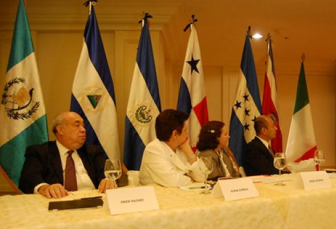Central America: Moving to a culture of peace

In the wake of International Youth Day 2012, a workshop involving the participation of key actors from the regional and state levels, as well as civil society, was held in San Salvador. Participants came together to discuss regional guidelines for the prevention of violence. The guidelines were developed based on Interpeace’s broad experience in the Central American region and will be drawn upon by the Central American Integration System (SICA) to define regional guidelines for the prevention of violence.
“For Central America, it is important to be able to rely on general guidelines. Each country has its policies, but much of the problem of violence is regional and requires a regional response,” explains Max Loría, Vice Minister of Peace of the Republic of Costa Rica, who attended the workshop along with several other representatives of Central American states as well as of SICA and the United Nations Population Fund (UNFPA).
10 Priority Strategies
The workshop was designed around the Ten Priority Strategies for Central American Youth. Regional Guidelines for the Social Prevention of Youth-Related Violence, produced by Interpeace. “The document benefited from insights gathered during the implementation of Interpeace’s Youth Programme across Central America,” Isabel Aguilar, Director of Interpeace’s Central American Youth Programme tells us. “We took proposals from each country in the region into account, so as to underpin a regional vision of youth-related violence and ways to prevent it.”
“The key here is that there is a consensus around the issues on which we should focus,” Mr. Loría points out. “For example, the issue of education: how can we strengthen education and use it as a prevention tool?” The Ten Priority Strategies address factors that increase the likelihood of young people getting caught up in a violent environment. They stress the need to make sure their basic rights and needs, such as education, healthcare, employment and expression opportunities are met, particularly for vulnerable groups. They also focus on the reinsertion and rehabilitation of those who are in conflict with the law.
The guidelines are intended to consolidate regional efforts and articulate visions around the prevention of violence and building a culture of peace for Central American youth, not as an isolated group, but as a contribution to society as a whole. “Young people not only represent the largest part of the population, but also the most important” according to Mr. Loría, “because they hold the assets in employment and the work force.”
Involving youth in the implementation
While participants agreed about the value of regional strategies and cooperation among Central American countries, they also highlighted the need to involve people at the local level, particularly the youth, in the implementation of these guidelines. “It is a very difficult task to move from these dialogues to the operational part,” says Douglas Urbina, Officer of the Honduras National Programme for Prevention, Rehabilitation and Social Reinsertion. “We are talking about local and concrete work with communities, which is a very big challenge. The other part of the challenge would be how to build capacity so that the product of these dialogues gets implemented for the larger part of society.”
For Mr. Loría, “the participation of youth in the implementation of the programme is critical. When we talk about youth-related violence, it is important to emphasize that the vast majority of young people are good people. These are people who are studying, looking for jobs, working out their life projects. And while it is true that we have youth-related violence problems, the problem is limited to a minority. Young people should, through better organization, be more supportive of these minorities.”
“It is good to see that key actors from the state and regional level are keen to take up these issues as well, along with the significant civil society involvement”, concludes Isabel Aguilar. “This workshop helped enrich the paper with important recommendations ahead of its finalization”.
The ten priority strategies for Central American youth are as follows:
1) Promote respect for youth and their rights by means of communication for peace and actions for peaceful coexistence.
2) Programmes to address the basic needs for the reduction of risk factors for adolescents and youth: education, health and employment with a focus on human rights and a culture of peace.
3) Development of youth through art, games, culture, sport, recreation and community involvement with a non-violent approach to conflict management, mutual respect and promoting diversity.
4) Improvement and expansion of public safety from a democratic and human rights perspective.
5) Comprehensive interventions focused on particularly vulnerable groups (homeless youth, youth with addictions or substance abuse problems, victims of sexual and economic exploitation and youth from homes and communities with high levels of violence, among others).
6) Establishment, expansion and prioritization of funding sources for the rehabilitation and social integration of young gang members or supporters, and youth groups associated with violence.
7) Promote inter-agency programmes to assist victims of any form of violence.
8) Ensure access to justice, due process and the respect for human rights of adolescents and youth in conflict with the law.
9) Create, promote and prioritize alternatives to detention for youth accused and / or found guilty of a criminal offense.
10) Implement rehabilitation and social insertion to minimize the negative impact of prison systems and the chances of repeated offences.
